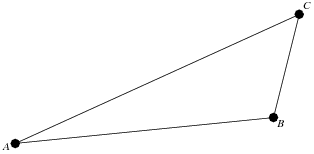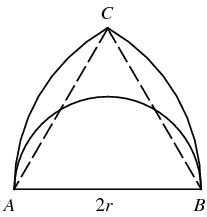


 تاريخ الرياضيات
تاريخ الرياضيات
 الرياضيات في الحضارات المختلفة
الرياضيات في الحضارات المختلفة 
 الرياضيات المتقطعة
الرياضيات المتقطعة
 الجبر
الجبر
 الهندسة
الهندسة 
 المعادلات التفاضلية و التكاملية
المعادلات التفاضلية و التكاملية 
 التحليل
التحليل
 علماء الرياضيات
علماء الرياضيات |
Read More
Date: 2-2-2020
Date: 18-12-2020
Date: 28-9-2020
|

An obtuse triangle is a triangle in which one of the angles is an obtuse angle. (Obviously, only a single angle in a triangle can be obtuse or it wouldn't be a triangle.) A triangle must be either obtuse, acute, or right.
From the law of cosines, for a triangle with side lengths  ,
,  , and
, and  ,
,
 |
(1) |
with  the angle opposite side
the angle opposite side  . For an angle to be obtuse,
. For an angle to be obtuse,  . Therefore, an obtuse triangle satisfies one of
. Therefore, an obtuse triangle satisfies one of  ,
,  , or
, or  .
.
An obtuse triangle can be dissected into no fewer than seven acute triangles (Wells 1986, p. 71).
A famous problem is to find the chance that three points picked randomly in a plane are the polygon vertices of an obtuse triangle (Eisenberg and Sullivan 1996). Unfortunately, the solution of the problem depends on the procedure used to pick the "random" points (Portnoy 1994). In fact, it is impossible to pick random variables which are uniformly distributed in the plane (Eisenberg and Sullivan 1996). Guy (1993) gives a variety of solutions to the problem. Woolhouse (1886) solved the problem by picking uniformly distributed points in the unit disk, and obtained
 |
(2) |
The problem was generalized by Hall (1982) to  -dimensional ball triangle picking, and Buchta (1986) gave closed form evaluations for Hall's integrals.
-dimensional ball triangle picking, and Buchta (1986) gave closed form evaluations for Hall's integrals.

In 1893, Lewis Carroll (1976) posed and gave another solution to the problem as follows. Call the longest side of a triangle  , and call the diameter
, and call the diameter  . Draw arcs from
. Draw arcs from  and
and  of radius
of radius  . Because the longest side of the triangle is defined to be
. Because the longest side of the triangle is defined to be  , the third polygon vertex of the triangle must lie within the region
, the third polygon vertex of the triangle must lie within the region  . If the third polygon vertex lies within the semicircle, the triangle is an obtuse triangle. If the polygon vertex lies on the semicircle (which will happen with probability 0), the triangle is a right triangle. Otherwise, it is an acute triangle. The chance of obtaining an obtuse triangle is then the ratio of the area of the semicircle to that of
. If the third polygon vertex lies within the semicircle, the triangle is an obtuse triangle. If the polygon vertex lies on the semicircle (which will happen with probability 0), the triangle is a right triangle. Otherwise, it is an acute triangle. The chance of obtaining an obtuse triangle is then the ratio of the area of the semicircle to that of  . The area of
. The area of  is then twice the area of a circular sector minus the area of the triangle.
is then twice the area of a circular sector minus the area of the triangle.
 |
(3) |
Therefore,
 |
(4) |
REFERENCES:
Buchta, C. "A Note on the Volume of a Random Polytope in a Tetrahedron." Ill. J. Math. 30, 653-659, 1986.
Carroll, L. Pillow Problems & A Tangled Tale. New York: Dover, 1976.
Eisenberg, B. and Sullivan, R. "Random Triangles  Dimensions." Amer. Math. Monthly 103, 308-318, 1996.
Dimensions." Amer. Math. Monthly 103, 308-318, 1996.
Guy, R. K. "There are Three Times as Many Obtuse-Angled Triangles as There are Acute-Angled Ones." Math. Mag. 66, 175-178, 1993.
Hall, G. R. "Acute Triangles in the  -Ball." J. Appl. Prob. 19, 712-715, 1982.
-Ball." J. Appl. Prob. 19, 712-715, 1982.
Portnoy, S. "A Lewis Carroll Pillow Problem: Probability on at Obtuse Triangle." Statist. Sci. 9, 279-284, 1994.
Wells, D. The Penguin Dictionary of Curious and Interesting Numbers. Middlesex, England: Penguin Books, p. 71, 1986.
Wells, D. G. The Penguin Book of Interesting Puzzles. London: Penguin Books, pp. 67 and 248-249, 1992.
Woolhouse, W. S. B. Solution to Problem 1350. Mathematical Questions, with Their Solutions, from the Educational Times, 1. London: F. Hodgson and Son, 49-51, 1886.



|
|
|
|
"عادة ليلية" قد تكون المفتاح للوقاية من الخرف
|
|
|
|
|
|
|
ممتص الصدمات: طريقة عمله وأهميته وأبرز علامات تلفه
|
|
|
|
|
|
|
المجمع العلمي للقرآن الكريم يقيم جلسة حوارية لطلبة جامعة الكوفة
|
|
|